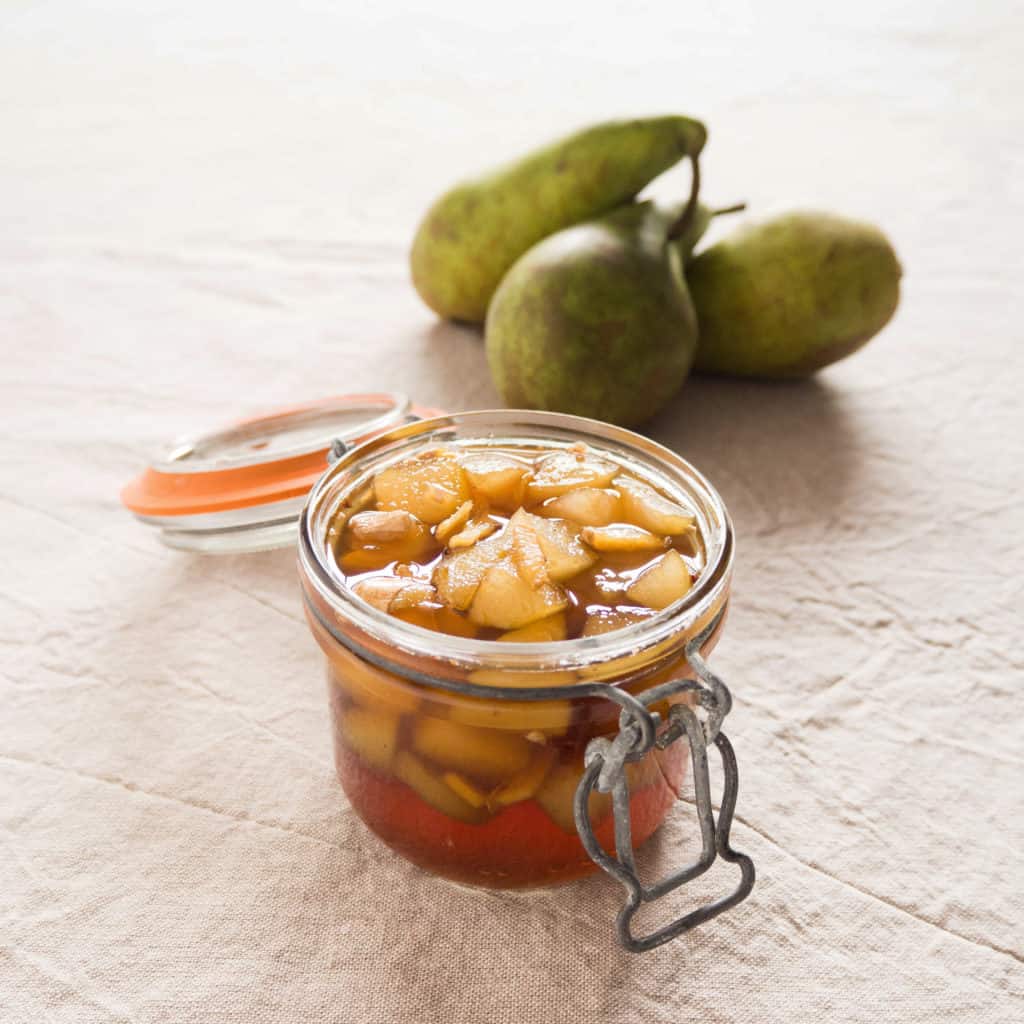
Pear and Ginger Whizz is a wonderful dark, sweet, musty, cordial that makes use of the glut of pears in the summer. Sweet, musty pears with earthy, spicy ginger is a wonderful combination. It is a relaxing, grounding drink which is perfect to end a hot, dusty day. Great mixed with sparkling water or… for grown-ups you could add a touch of your favourite fizzy wine (Prosecco is wonderful) for a glorious sundowner. It’s the weekend, treat yourself!
Pear and Ginger Whizz is so easy to make. It stores well for three to four weeks in the fridge or keeps in the freezer for six months or so.
You can find the full Pear and Ginger Whizz recipe here.
As well as the traditional drink you can also use Pear and Ginger Whizz to make a wonderful sorbet, ice lollies or drizzle over ice-cream, Summer Lemon Sorbet, fruit salad or breakfast porridge. You can also use it as a mixer with gin or vodka! As well as the cordial you can also use the pears which are great with ice-cream or sorbet.
The best way to sterilise jars, funnels and other equipment is in the dishwasher. Just make sure when you remove items from the dishwasher you do not ‘de-sterilise’ them by touching any inside surface.
Preparation
Difficulty easy
Preparation time 5 minutes
Cooking time 25 minutes
You can find the full Pear and Ginger Whizz recipe here.
Allergens
Pear and Ginger Whizz is gluten-free and vegan as well as…
Celery free
Coconut free
Garlic free
Lupin free
Mustard free
Nightshade free
Onion free
Peanut free
Sesame free
Soya free
Tree nut free
About
The pear can be one of several tree and shrub species of genus pyrus in the family rosaceae. Pear is also the name of the pomaceous fruit of the trees. Several species of pear are valued for their edible fruit and juices, while others are cultivated as ornamental trees.
The pear is native to coastal and mildly temperate regions of western Europe and north Africa east and across Asia. Pear trees are medium-sized, reaching 10–17 metres in height, often with a tall, narrow crown. There are a few shrub species. Most pear trees are deciduous however, one or two species in southeast Asia are evergreen. Most trees are cold-hardy, withstanding temperatures between −25 °C and −40 °C in winter (except for the evergreen species, which only tolerate temperatures down to about −15 °C).
In most wild species of pear the fruit is one to four centimetres diameter however, in some cultivated forms the fruit is up to 18 centimetres long and 8 centimetres wide. The shape varies from round to the classic ‘pear-shape’ of the European pear. It is sometimes difficult to distinguish between pear and apple fruit: some pears look like some apples, e.g. the nashi pear. One major distinguishing factor is that the flesh of pear fruit contains stone cells (also called “grit”).
Evidence of pear cultivation has been found in prehistoric pile dwellings around Lake Zurich. The pear was also cultivated by the Romans, who ate the fruits raw or cooked, just like apples. Pliny’s Natural History recommended stewing them with honey and noted three dozen varieties. The Roman cookbook De re coquinaria has a recipe for a spiced, stewed-pear patina, or soufflé. Pears have been cultivated in China for approximately 3000 years.
Ginger (zingiber officinale) is a widely available spice today and is used in sweet and savoury cooking and baking across the world. It is thought that ginger originated in southeast Asia and was brought to Europe in the 1st century by traders. Ginger was a popular spice in Rome. Ginger fell from use with the fall of the Roman Empire.
A serving of 100 grams of ground dried ginger provides manganese as a multiple of its RDA. In a typical spice serving amount of five grams, however, ginger powder provides negligible content of essential nutrients, with the exception of manganese present as 79% of RDA. Fresh, root ginger has a high water content (80%) and so raw ginger root has a low overall nutrient per 100 grams.
Ginger is a hot, fragrant spice that can be used fresh, dried, pickled or crystalised. It is the ultimate versatile spice used in sweet and savoury dishes from curries to cakes to stir fries and as condiments. Ginger is pretty amazing.